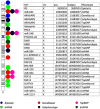Identifying X-chromosome variants associated with age-related macular degeneration
- PMID: 39324238
- PMCID: PMC11630753
- DOI: 10.1093/hmg/ddae141
Identifying X-chromosome variants associated with age-related macular degeneration
Abstract
Purpose: In genome-wide association studies (GWAS), X chromosome (ChrX) variants are often not investigated. Sex-specific effects and ChrX-specific quality control (QC) are needed to examine these effects. Previous GWAS identified 52 autosomal variants associated with age-related macular degeneration (AMD) via the International AMD Genomics Consortium (IAMDGC), but did not analyze ChrX. Therefore¸ our goal was to investigate ChrX variants for association with AMD.
Methods: We genotyped 29 629 non-Hispanic White (NHW) individuals (M/F:10404/18865; AMD12,087/14723) via a custom chip and imputed after ChrX-specific QC (XWAS 3.0) using the Michigan Imputation Server. Imputation generated 1 221 623 variants on ChrX. Age, informative PCs, and subphenotypes were covariates for logistic association analyses with Fisher's correction. Gene/pathway analyses were performed with VEGAS, GSEASNP, ICSNPathway, DAVID, and mirPath.
Results: Logistic association on NHW individuals with sex correction identified variants in/near the genes SLITRK4, ARHGAP6, FGF13 and DMD associated with AMD (P < 1 × 10-6,Fisher's combined-corrected). Association testing of the subphenotypes of choroidal neovascularization and geographic atrophy (GA), identified variants in DMD associated with GA (P < 1 × 10-6, Fisher's combined-corrected). Via gene-based analysis with VEGAS, several genes were associated with AMD (P < 0.05, both truncated tail strength/truncated product P) including SLITRK4 and BHLHB9. Pathway analysis using GSEASNP and DAVID identified genes associated with nervous system development (FDR: P:0.02), and blood coagulation (FDR: P:0.03). Variants in the region of a microRNA (miR) were associated with AMD (P < 0.05, truncated tail strength/truncated product P). Via DIANA mirPath analysis, downstream targets of miRs showed association with brain disorders and fatty acid elongation (P < 0.05). A long noncoding RNA on ChrX near the DMD locus was also associated with AMD (P = 4 × 10-7). Epistatic analysis (t-statistic) for a quantitative trait of AMD vs control including covariates found a suggestive association in the XG gene (P = 2 × 10^-5).
Conclusions: Analysis of ChrX variation identifies several potential new locifor AMD risk and these variants nominate novel AMD pathways. Further analysis is needed to refine these results and to understand their biological significance and relationship with AMD development in worldwide populations.
Keywords: X chromosome; age-related macular degeneration; genome wide association study; non-coding.
© The Author(s) 2024. Published by Oxford University Press.
Figures
Update of
-
Identifying X-Chromosome Variants Associated with Age-Related Macular Degeneration.medRxiv [Preprint]. 2023 Aug 31:2023.08.28.23294688. doi: 10.1101/2023.08.28.23294688. medRxiv. 2023. Update in: Hum Mol Genet. 2024 Dec 6;33(24):2085-2093. doi: 10.1093/hmg/ddae141. PMID: 37693625 Free PMC article. Updated. Preprint.
References
-
- Friedman DS, O’Colmain BJ, Muñoz B. et al. Prevalence of age-related macular degeneration in the United States. Arch Ophthalmol 2004;122:564–572. - PubMed
-
- Avisar R, Friling R, Snir M. et al. Estimation of prevalence and incidence rates and causes of blindness in Israel, 1998–2003. Isr Med Assoc J 2006;8:880–881. - PubMed
-
- Rein DB, Wittenborn JS, Zhang X. et al. Forecasting age-related macular degeneration through the year 2050: the potential impact of new treatments. Arch Ophthalmol 2009;127:533–540. - PubMed
MeSH terms
Grants and funding
LinkOut - more resources
Full Text Sources
Medical


